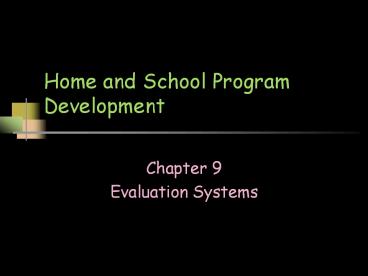Home and School Program Development - PowerPoint PPT Presentation
1 / 15
Title:
Home and School Program Development
Description:
Use as a Prompt System for making Proactive Program Improvements ... manners, facial expression, voice tone & volume, greeting skills, independence, ... – PowerPoint PPT presentation
Number of Views:15
Avg rating:3.0/5.0
Title: Home and School Program Development
1
Home and School Program Development
- Chapter 9
- Evaluation Systems
2
Using ABA Principles within Your Organization
- Organizational charts
- Majority of positions must be held by behavior
analysts - Verbal behavior
- Aides/instructors trainers/supervisors
- Group contingencies
- Rewarding measurable success of trainers and
instructors - Rewards should be
- praise from a mentor
- invitation to discuss successful intervention
procedure at a staff meeting - expanded authority and job responsibilites
- invitation to participate in a new research
project
3
Using ABA Principles within Your Organization
- Training expertise
- Direct-hands on training
- Modeling and Feedback
- Teach skills in receiving and implementing
feedback - Teach skills in giving positive and corrective
feedback - Shaping trainee performance
- Consumer Evaluation
- Survey staff members frequently
- Rating scales and written feedback
- Use as a Prompt System for making Proactive
Program Improvements - Use data to implement meaningful change
4
Evaluation of Staff Performance
- Everyone in the organization is evaluated
- Produce more rewards than punishers
- Result in new training plans that further enable
staff to teach, learn, and evaluate additional
skills - Serve as prompt systems
- Evaluations consist of a training protocol
5
Evaluation Protocol
- On-task behavior of students
- Opportunities to Respond
- Behavior Specific Praise rate of reinforcement
- Incidental Teaching
- Programming Assessing Generalization
- Understanding Intervention Technology
6
Evaluation Protocol
- Professionalism
- Appearance, use of feedback model, neat work
environment, concern for students, punctual,
stays on-task, seeks opportunities to develop new
skills, knows the programs they teach, good
collegial relationships
7
Evaluation Protocol
- Teaching New Skills
- Gains students attention, clear instructions,
teaches learner to initiate, smooth transitions,
contingently uses a variety of rewards, use of
prompts, activity schedules, motivational
systems,
8
Evaluation Protocol
- Social Competence
- Teaches models hygiene, grooming, manners,
facial expression, voice tone volume, greeting
skills, independence, teaches skills rewarding to
others, teaches tasks to criterion, teaches peer
interaction, social initiations language,
9
Evaluation Protocol
- Relationship Building
- Smiles at students, provides age-appropriate
physical contact, appears enthusiastic, pleasant,
identifies novel relationship-building
activities, makes positive statement to and about
students, credits colleagues
10
Evaluation Protocol
- Decreases Problem Behavior
- Knows response definitions Treatment protocols,
appropriate voice tone touch, teaching of
incompatible behavior and use of proactive
strategies, accurate data collection
11
Evaluation of Treatment Outcomes
- Number of students per year who successfully
transition to general education - Measurement of skill acquisition for
individualized programs
12
Evaluation of Treatment Outcomes
- Graph Labels
- condition lines, sets, teaching procedures,
explanation of inconsistent data, data gaps - Data
- Consistently collection, criterion levels, new
sets immediately implemented
13
Evaluation of Treatment Outcomes
- Number of programs reviewed
- Percentage of individualized programs
- Written response definition, data collection
procedure, baseline/treatment, graph - Percentage of programs rated effective
- Behavior change in desired direction
- Percentage of programs rated appropriate
- Treatment may continue
- Percentage of programs with current consent
- Percentage of programs with some/any
interobserver agreement
14
Systems
- Non-departmentalized
- All trainers are evaluators
- Trainees evaluation result is the measure of a
trainer - In summary
- Administrative success is defined by the data on
trainer/evaluator behavior, intervention agents
performance treatment outcome and consumer
satisfaction
15
References
- McClannahan, L. E. Krantz, P. J. (2004). Some
guidelines for selecting behavioral intervention
programs for children with autism. In H. E. Brigs
and T. L. Rzepnicki (Eds.), Using social work
practice Behavioral perspectives. Chicago, IL
Lyceum. - McClannahan, L. E. Krantz, P.J. (1993). On
systems analysis in autism intervention programs.
Journal of Applied Behavior Analysis, 26,
589-596.































